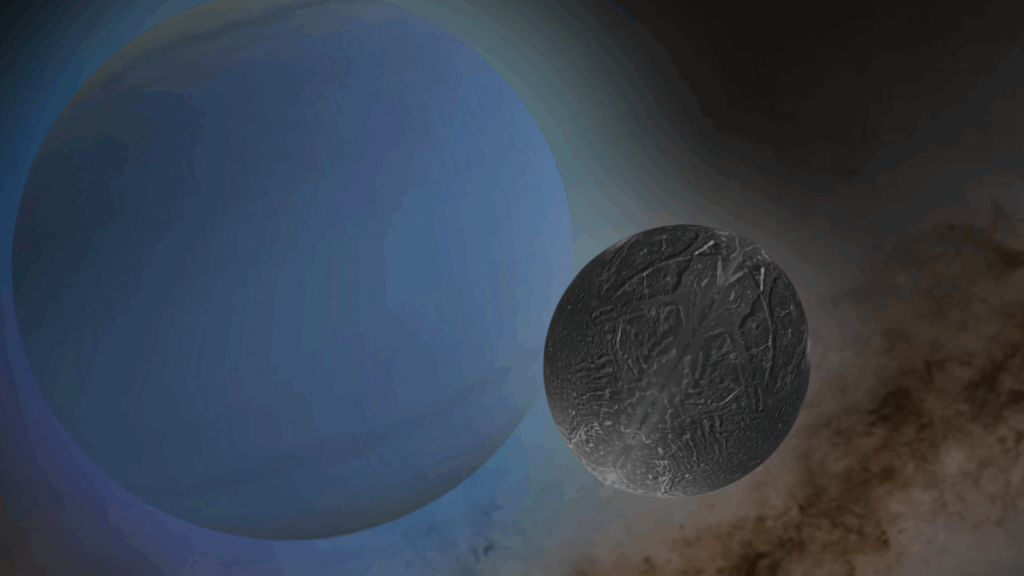
Recent research indicates that Ariel, one of Uranus’ icy moons, may have concealed a vast ocean beneath its frozen surface. The study suggests that this hidden ocean could have been more than 100 miles (170 kilometers) deep, adding to the growing body of evidence that Uranus’ moons might have been ocean worlds in the distant past.
At 720 miles (1,159 kilometers) in diameter, Ariel is smaller than many of Jupiter’s and Saturn’s moons. Yet, its surface is notably bright and complex, featuring ancient cratered terrain alongside younger, smoother plains likely shaped by cryovolcanism, a type of volcanic activity that occurs on icy bodies. According to Alex Patthoff, a senior scientist at the Planetary Science Institute in Arizona and co-author of the study, “Ariel is pretty unique in terms of icy moons.”
The research, led by Caleb Strom from the University of North Dakota, aimed to uncover the moon’s past interior structure and orbital eccentricity. By modeling how Uranus’ gravity would have affected Ariel over time, the researchers sought to explain the dramatic surface features visible today. Their analysis revealed that Ariel’s orbit likely had an eccentricity of approximately 0.04, which is about 40 times greater than its current orbit. This eccentricity would have made its orbit four times more eccentric than that of Europa, Jupiter’s icy moon known for its geologically active surface.
The scale of the cracks and ridges observed on Ariel’s surface suggests that its icy crust was flexing over a liquid layer. The researchers concluded that either a massive ocean lay beneath a relatively thin ice shell, or a smaller ocean existed under stronger orbital stresses. “But either way, we need an ocean to be able to create the fractures that we are seeing on Ariel’s surface,” Patthoff stated.
This study builds on findings from a 2024 investigation that indicated a subsurface ocean on another of Uranus’ moons, Miranda. Together, these results imply that Uranus may have hosted multiple ocean-bearing satellites. Tom Nordheim, co-author of the study and principal investigator of the NASA grant supporting the research, commented, “We are finding evidence that the Uranus system may harbor twin ocean worlds.”
The existence of subsurface oceans is significant in planetary science, as they could provide potential habitats for life. Liquid water is essential for biological processes, and in hidden oceans beneath ice shells, tidal heating or radioactive decay can supply the necessary energy to sustain life, even in the far reaches of the solar system.
While scientists have yet to determine when Ariel’s ocean formed, how long it lasted, or if it still exists, the findings contribute to understanding how such oceans evolve in the outer solar system. The research also reinforces increasing calls for a dedicated mission to Uranus. The proposed Uranus Orbiter and Probe, identified by the National Academies’ planetary science decadal survey as NASA’s highest-priority flagship mission for 2023–2032, would orbit the planet for a minimum of five years. It aims to deploy an atmospheric probe and thoroughly investigate Uranus’ rings and moons.
Despite Congress not yet allocating funding for this mission, scientists argue that it could address major questions surrounding Uranus’ extreme axial tilt, its dense ring system, and its potentially ocean-bearing moons. The need for exploration is pressing; as Kathleen Mandt, a planetary scientist at The Johns Hopkins University Applied Physics Laboratory, previously noted, such a mission could be transformative, akin to how NASA’s Cassini mission revolutionized our understanding of Saturn.
Currently, spacecraft have only captured images of the southern hemispheres of Ariel and Miranda. The models developed by the research team may help predict what a future mission could discover in the unexplored northern regions, including additional fractures, ridges, and resurfaced terrain. “Ultimately, we just need to go back to the Uranus system and see for ourselves,” Nordheim emphasized.
The complete study was published in the January 2026 edition of the scientific journal Icarus.







